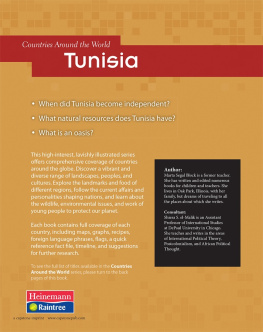
www.capstonepub.com
Visit our website to find out more information about Heinemann-Raintree books.
To order:

Phone 888-454-2279

Visit www.capstonepub.com
to browse our catalog and order online.
2012 Heinemann Library an imprint of Capstone Global Library, LLC Chicago, Illinois
All rights reserved. No part of this publication may be reproduced or transmittedin any form or by any means, electronic or mechanical, including photocopying, recording,taping, or any information storage and retrieval system, without permission in writingfrom the publisher.
Edited by Abby Colich and Megan Cotugno
Designed by Philippa Jenkins
Original illustrations Capstone Global Library, Ltd.
Illustrated by Oxford Designers & Illustrators
Picture research by Liz Alexander
Originated by Capstone Global Library, Ltd.
15 14 13 12 11
10 9 8 7 6 5 4 3 2 1
Library of Congress Cataloging-in-Publication Data
Block, Marta Segal.
Egypt / Marta Segal Block.
p. cm.(Countries around the world)
Includes bibliographical references and index.
ISBN 978-1-4329-6097-1 (hb)ISBN 978-1-4329-6123-7 (pb)
ISBN 978-1-4846-1098-5 (eBook)
1. EgyptJuvenile literature. 2. EgyptHistoryJuvenile literature. I. Title. II. Series: Countries around the world (Chicago, Ill.)
DT49.B56 2012
962dc22 2011015259
Acknowledgments
We would like to thank the following for permission to reproduce photographs: TheArt Archive: pp. 8 (Collection Antonovich / Gianni Dagli Orti), 10 (Muse du Chteaude Versailles / Gianni Dagli Orti); Corbis: pp. 20 ( Goran Tomasevic/ Reuters),24 ( Tara Todras-Whitehill/Reuters), 29 ( Lynsey Addario/VII Network), 34 ( epa);Dreamstime.com: p. 25 ( Markwaters); Getty Images: pp. 7 (Ethan Miller), 12-13:(Hulton Archive), 17 (AFP), 28 (David Silverman), 30 (Cris Bouroncle/ AFP), 36 (MisamSaleh/AFP); Photolibrary: pp. 11 (Steve Vidler), 19 (Henryk T Kaiser); Photoshot:p. 31 (Peter Schickert); Shutterstock: pp. 5 ( bumihills), 21 ( Peter Zaharov),22 ( Roger De Marfa), 23 ( Uryadnikov Sergey), 27 ( Baloncici), 32 ( Louise Cukrov),33( CWB), 35 ( Brandelet), 37 ( Bzzuspajk), 46 ( Sportnet).
Cover photograph of Bazaar at Khan Al-Khalili, Cairo, Egypt, reproduced with permissionfrom Photolibrary (Radius Images).
We would like to thank Shiera S. el-Malik for her invaluable help in the preparationof this book.
Every effort has been made to contact copyright holders of material reproduced inthis book. Any omissions will be rectified in subsequent printings if notice is givento the publisher.
Disclaimer
All the Internet addresses (URLs) given in this book were valid at the time of goingto press. However, due to the dynamic nature of the Internet, some addresses mayhave changed, or sites may have changed or ceased to exist since publication. Whilethe author and publisher regret any inconvenience this may cause readers, no responsibilityfor any such changes can be accepted by either the author or the publisher.
Contents
Some words are printed in bold, like this . You can find out what they mean by lookingin the glossary.
Introducing Egypt
When many people think of Egypt, they think of things like mummies, pyramids, hieroglyphics ,the Sphinx, Pharaohs , King Tut, and the Nile River.
These are all important parts of this ancient country, but the country is also somuch more. Egypts Nile River has fed people for centuries, providing papyrus , theworlds first paper, and also the first agriculture. Built in 1970, the Aswan Dam remains an important and controversial engineering feat.
Languages of Egypt
The official name of Egypt is the Arab Republic of Egypt. In Arabic it is called Jumhuriyat Misr al-Arabiyah or Misr for short. Although English, French, and Germanare widely spoken in Egypt, Arabic is the official language. Many Egyptians alsospeak a language known as Egyptian Arabic.
Egypt is very important politically. It was the first Arab country to make peacewith neighboring Israel. This makes Egypt a valuable friend to countries throughoutthe world, including the United States.
Visiting Egypt
Located in northern Africa, Egypt is 384,345 square miles (995,450 square kilometers)in size. Thats bigger than the state of Texas, but not quite as big as Alaska. Tourismis the countrys largest source of foreign money. For centuries people have flockedto this country to see the pyramids and other ancient artifacts.
How to say...
Salaam is the Arabic word for peace. It is often used as a greeting.

The Nile River has always been essential to Egypts growth.
History: The Land of the Pharaohs
The Nile River has drawn people to Egypt for centuries. Over 8,000 years ago, huntersand fishers first settled nearby. As they learned to work with the Nile River andits regular patterns of flooding and drought , they began to grow certain kinds ofgrain. Later, they also kept animals.
The Nile River allowed people to travel to other parts of Africa, trading and bringingback ideas. By 3000 BCE, the Nile people were their own civilization . The ancientEgyptians also had their own written language known as hieroglyphics .
This chart shows some common hieroglyphics and their translations.
The Pharaohs
In about 3100 BCE, two kingdoms known as Upper and Lower Egypt united under a powerfulleader. This leader came to be known as a Pharaoh . The Pharaohs conquered new landsincluding Nubia (modern-day Sudan), Palestine (modern-day Israel), and Syria.
Although it was unusual in the ancient world, ancient Egyptian women could inheritand own property, and even ask for a divorce. Further, women could become Pharaoh.The earliest female Pharaoh was Meryt-Neith. She was possibly the third Pharaoh andruled for almost three years. The longest ruling female Pharaoh was Hatshepsut. Whilethe exact years of her rule are difficult to determine, she had power for over 15years. In portraits Hatshepsut is almost always depicted as a man with a traditionalbeard.
King Tut (Tutankhamen) is the Pharaoh most famous today, but most historians believehe was a fairly unimportant ruler in his own time.
Alexander the Great
In 332 BCE, Alexander the Great of Macedonia conquered Egypt. Macedonia is near Greecein Europenot very close to Egypt. Alexander founded the Ptolemy dynasty of Pharaohsas well as the city of Alexandria, which he named for himself. Since its founding,Alexandria has been known as an important city for learning.
From Greece to Rome
The last Ptolemy Pharaoh was Queen Cleopatra. Cleopatra tried to attack the RomanEmpire , but lost. In 31 BCE, Egypt came under Roman rule. Over the next 300 years,Rome changed the Egyptian culture, making Christianity the official religion. TheEgyptian Christians were known as Coptics, and many still live in Egypt today.




















